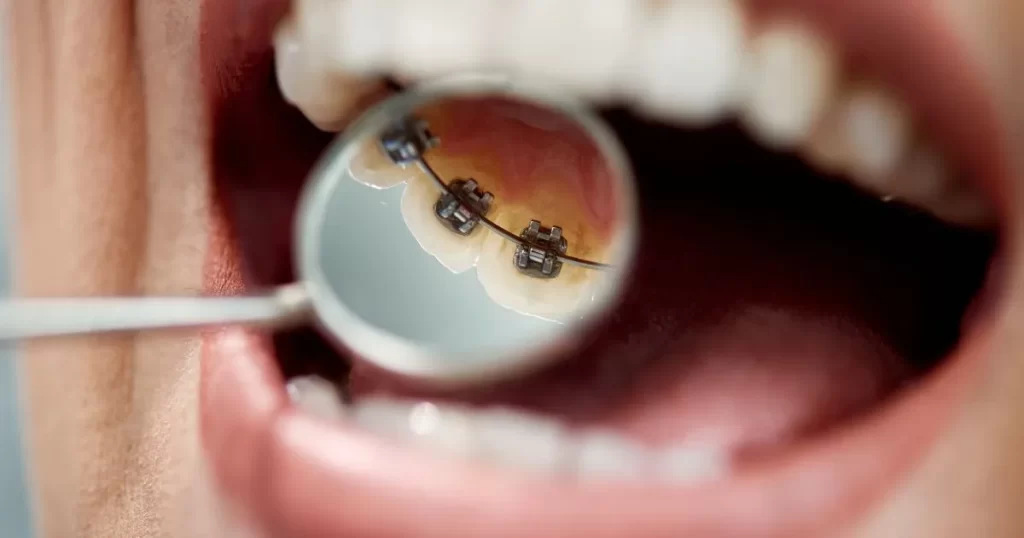Lingual Braces
- Home
- Dental Braces
- Lingual Braces
Do you want straighter teeth but don’t want anyone to know you’re wearing braces? Lingual braces may be the solution for you. Lingual braces are an innovative orthodontic treatment that are hidden behind your teeth, making them virtually invisible. In this article, we will explore what lingual braces are, how they work, their advantages and disadvantages, and how to care for them.
Are you self-conscious about wearing traditional braces on the front of your teeth? Do you want to straighten your teeth without anyone knowing? Lingual braces may be the solution you’re looking for. In this article, we’ll explore what lingual braces are, how they work, and their benefits and drawbacks.

Lingual braces are similar to traditional metal braces, but they are attached to the back of your teeth instead of the front. They are custom-made to fit your teeth and are attached using special brackets and wires. Lingual braces are completely hidden from view, making them a great option for people who want to straighten their teeth without the appearance of traditional braces.
Lingual braces are custom-made to fit the unique shape of your teeth and are attached to the back of your teeth using special brackets and wires. They work in the same way as traditional braces, gradually applying pressure to your teeth to move them into the desired position.
Lingual braces work in the same way as traditional braces, by applying gentle pressure to your teeth to move them into the desired position. The main difference is that lingual braces are attached to the back of your teeth instead of the front. This means that the brackets and wires are custom-made to fit the shape of your teeth and are completely hidden from view.
The process of getting lingual braces typically involves several appointments with your orthodontist. During the first appointment, your orthodontist will take impressions of your teeth to create custom brackets and wires. In the second appointment, the lingual braces will be attached to the back of your teeth using a special bonding agent. Your orthodontist will then adjust the wires periodically to gradually move your teeth into the desired position.
The main advantage of lingual braces is their discreet appearance. Because they are hidden behind your teeth, you can straighten your teeth without anyone knowing you’re wearing braces. This makes lingual braces a great option for adults who want to improve their smile without the embarrassment of wearing traditional braces.
Another advantage of lingual braces is that they are custom-made to fit your teeth. This means that they are more comfortable than traditional braces and can be more effective in treating certain orthodontic issues.
While lingual braces have many advantages, they also have some disadvantages. The main disadvantage is that they can be more difficult to clean and maintain than traditional braces. Because they are attached to the back of your teeth, it can be challenging to brush and floss around the brackets and wires. This can lead to an increased risk of tooth decay and gum disease if proper oral hygiene is not maintained.
Another disadvantage of lingual braces is that they can be more expensive than traditional braces. The custom-made brackets and wires require specialized training and equipment, which can drive up the cost of treatment.
Finally, lingual braces may not be suitable for everyone. They may not be as effective in treating severe orthodontic issues and may not be recommended for people with certain dental conditions.
Caring for lingual braces is similar to caring for traditional braces, but there are some additional considerations you should keep in mind. Here are some tips for caring for your lingual braces:
- Brush and floss regularly: It’s important to maintain good oral hygiene when you have lingual braces. Brush your teeth at least twice a day, and floss at least once a day. You may need to use special tools or techniques to clean between the brackets and wires.
Avoid hard or sticky foods: Hard or sticky foods can damage your braces or get stuck in the brackets and wires. Avoid foods like hard candy, nuts, popcorn, and chewing gum.
Attend regular check-ups: It’s important to attend regular check-ups with your orthodontist to ensure that your lingual braces are working properly and to make any necessary adjustments.
Wear a mouthguard during sports: If you play sports, wear a mouthguard to protect your lingual braces and your teeth from injury.
Avoid smoking and excessive alcohol consumption: Smoking and excessive alcohol consumption can damage your lingual braces and increase the risk of oral health problems.
Lingual braces can be a great option for people who want to straighten their teeth without anyone knowing. They are custom-made, effective, and suitable for most orthodontic problems. However, they do have some drawbacks, including a higher cost and potential speech problems.
If you’re considering lingual braces, talk to your orthodontist about whether they are a good option for you. They can assess your orthodontic needs and help you decide whether lingual braces are the right choice.
Lingual braces are a great option for people who want to straighten their teeth without anyone knowing. They are custom-made, effective, and suitable for most orthodontic problems. While they do have some drawbacks, such as a higher cost and potential speech problems, they can produce great results in less time than traditional braces.
If you’re considering lingual braces, talk to your orthodontist about whether they are a good option for you. With proper care and regular check-ups, you can achieve a beautiful, straight smile with lingual braces.

